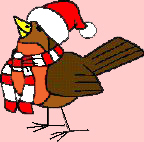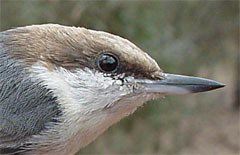|
|
|||
|
THIS WEEK at HILTON POND |
|
BIRD TICKS As December sets in, it's common for folks to call Hilton Pond Center with questions about unusual sightings at their backyard feeders. Perhaps they've seen a new species dining on sunflower seeds--one caller who's been feeding birds for 20 years phoned last week about his first-ever Brown-headed Nuthatches--and often someone is concerned because a Sharp-shinned Hawk is preying upon the local flock of American Goldfinches. (For the latter callers, our response is always this: If you're putting out thistle seeds to attract goldfinches, you're likewise putting out goldfinches to attract sharpies. Pull up a chair, watch the action, and consider yourself lucky for the opportunity to see a predator-prey encounter that is integral to the balance of nature.) 
All text & photos © Hilton Pond Center We also take calls when someone has observed a songbird suffering some sort of malady. For example, we get several queries each winter about House Finches that are "blind"--undoubtedly due to a highly contagious conjunctivitis that often clears up spontaneously with no apparent injury to the bird. And we've come to expect a number of inquiries about some Dark-eyed Junco or White-throated Sparrow that appears to have big tick-like lumps hanging from its head region. Our response: "Yes, indeed, they probably ARE ticks." In fact just this week we caught a Blue Jay with a tick attached to its lower right eyelid (above). Bird ticks are not epidemic, but they're certainly not uncommon. Some years there are more than others, and we've never been able to determine whether mild winters or wet summers or some other factor leads to an abundance of ticks. Our most common tick-bearing species is the Purple Finch, so perhaps a sizable segment of our tick population in the Carolina Piedmont actually hitchhikes in from further north where Purple Finches breed. As might be expected, ticks at Hilton Pond Center occur most frequently on ground-feeding birds; after all, many larval ticks spend part of their lives on the ground. In our first decade of banding, bird ticks were far more common at the Center than they have been in the past ten years; from 1982 through 1991 we banded 17,018 birds, and 157 of them bore ticks, as follows:
Although some birds recover from tick infestations with no noticeable side effects, there's little doubt ticks can be detrimental to their hosts--especially when a bird carries several at a time. We've caught Purple Finches with up to four ticks (below right); the record-holder was infested by a grand total of eight--all swelled to more than 3mm in diameter. In what was likely a misplaced gesture of compassion, we at one time used forceps to remove ticks from all birds we banded. Sometimes when we tugged on a tick, small pieces of membrane or other tissue from around the bird's eye would come out with the parasite. After further consideration, we decided we probably were doing more harm than good--especially since at least some birds appear to recover completely after a tick completes its blood meal and drops off. Thus, we quit harvesting ticks during the banding process and now simply observe the behavior of tick-laden birds at our feeders. We encourage folks who call Hilton Pond Center to do the same. If you enjoy "This Week at Hilton Pond," please help Support Hilton Pond Center for Piedmont Natural History. It's painless, and YOU can make a difference! You may wish to consult our Index of all nature topics covered since February 2000. |
|||||||||||||||||

 Nearly all ticks we've seen on birds have been attached near eyes, ear canals, crowns, or foreheads--the sorts of places where a beak can't nip. A bird probably also has trouble scratching off ticks with its claws, so it's easy for the parasite to hang onto a bird's head while taking a blood meal. The smallest readily detectable bird ticks are about 1mm long; the tick on the Blue Jay in the top photo has already ingested enough blood to expand its abdomen to about 3mm. By comparison, the fully engorged tick on a Dark-eyed Junco we trapped this week (above left) is almost 9mm long and undoubtedly dropped off within a day or two of when the bird was banded. The region around the junco's eye is badly swollen and the eye is very watery, but the tick may not have caused permanent physical damage to the bird. Several times we've trapped tick-bearing birds that seemed to be in great distress and close to death--only to recapture them a few weeks later with no signs of their previous affliction.
Nearly all ticks we've seen on birds have been attached near eyes, ear canals, crowns, or foreheads--the sorts of places where a beak can't nip. A bird probably also has trouble scratching off ticks with its claws, so it's easy for the parasite to hang onto a bird's head while taking a blood meal. The smallest readily detectable bird ticks are about 1mm long; the tick on the Blue Jay in the top photo has already ingested enough blood to expand its abdomen to about 3mm. By comparison, the fully engorged tick on a Dark-eyed Junco we trapped this week (above left) is almost 9mm long and undoubtedly dropped off within a day or two of when the bird was banded. The region around the junco's eye is badly swollen and the eye is very watery, but the tick may not have caused permanent physical damage to the bird. Several times we've trapped tick-bearing birds that seemed to be in great distress and close to death--only to recapture them a few weeks later with no signs of their previous affliction. Several ornithologists and parasitologists we've talked with are undecided whether these ticks transmit avian diseases from one bird to another--the jury still seems to be out on tick transmission of West Nile Virus--but just the blood loss caused by eight ectoparasites around a small bird's eyes and brain probably disrupts normal activities.
Several ornithologists and parasitologists we've talked with are undecided whether these ticks transmit avian diseases from one bird to another--the jury still seems to be out on tick transmission of West Nile Virus--but just the blood loss caused by eight ectoparasites around a small bird's eyes and brain probably disrupts normal activities.


